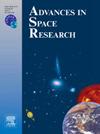A comprehensive survey of the GEO-belt using simultaneous four-colour observations with STING
IF 2.8
3区 地球科学
Q2 ASTRONOMY & ASTROPHYSICS
引用次数: 0
Abstract
Colour light curves of resident space objects (RSOs) encapsulate distinctive features that can offer insights into an object’s structure and design, making them an invaluable tool for classification and characterisation. We present the results of the first large systematic colour survey of the GEO (Geostationary Earth Orbit) belt in which we obtain full-night multi-colour light curves for 112 active geostationary objects between April and May 2023. This survey was undertaken during the ‘glint’ season using the STING telescope located at the Roque de Los Muchachos observatory in the Canary Islands.
Colour light curve maps were created to compare and contrast the colours between different satellites and bus configurations. We find that satellites with BSS-702 and STAR-2 buses can be effectively distinguished from the colour measurements on these maps, but comparing the average colour of individual satellites within given solar equatorial phase angle ranges shows that it is difficult to distinguish between bus configurations based on colour alone. We also find tentative evidence to suggest that there is a relationship between colour and time spent on orbit for the Eurostar-3000 class satellites, which is unseen behaviour within other bus configuration classes. The satellites in our sample exhibit ‘redder’ colours than the Sun, which is in agreement with previous findings.
We found common light curve features such as symmetrical colour changes as well as unique regions of short timescale glinting which are ‘bluer’ than other regimes within the colour light curves. If these features are indeed seasonal, this would be a powerful characterisation tool. We are able to detect and resolve features in the light curve of the LDPE-3A satellite related to manoeuvres being performed.
Finally, we measured the solar panel offsets of 54 satellites in our sample and found variation in the type of colour response. The majority of which did not exhibit any colour change across the solar panel glints compared to them shifting towards ’redder’ or ’bluer’ colours.
利用STING同步四色观测对geo带进行全面调查
驻留空间物体(rso)的彩色光曲线封装了独特的特征,可以提供对物体结构和设计的见解,使它们成为分类和表征的宝贵工具。我们展示了对地球静止轨道(GEO)带进行的首次大型系统彩色巡天的结果,我们获得了2023年4月至5月期间112个活跃地球静止物体的全夜间多色光曲线。这项调查是在“闪烁”季节进行的,使用的是位于加那利群岛Roque de Los Muchachos天文台的STING望远镜。彩色光曲线图是为了比较和对比不同卫星和总线配置之间的颜色。我们发现带有BSS-702和STAR-2总线的卫星可以有效地与这些地图上的颜色测量区分开来,但是比较给定太阳赤道相位角范围内单个卫星的平均颜色表明,仅基于颜色很难区分总线配置。我们还发现初步证据表明,欧洲之星3000级卫星的颜色和在轨道上花费的时间之间存在关系,这在其他总线配置类别中是看不见的行为。我们样本中的卫星呈现出比太阳更“红”的颜色,这与之前的发现一致。我们发现了常见的光曲线特征,如对称的颜色变化,以及独特的短时间尺度闪烁区域,这些区域比彩色光曲线中的其他区域“更蓝”。如果这些特征确实是季节性的,这将是一个强大的特征描述工具。我们能够在LDPE-3A卫星的光曲线中检测和解析与正在进行的演习有关的特征。最后,我们测量了样本中54颗卫星的太阳能电池板偏移量,发现了颜色响应类型的变化。它们中的大多数在太阳能电池板上没有表现出任何颜色变化,相比之下,它们会向“更红”或“更蓝”的颜色转移。
本文章由计算机程序翻译,如有差异,请以英文原文为准。
求助全文
约1分钟内获得全文
求助全文
来源期刊

Advances in Space Research
地学天文-地球科学综合
CiteScore
5.20
自引率
11.50%
发文量
800
审稿时长
5.8 months
期刊介绍:
The COSPAR publication Advances in Space Research (ASR) is an open journal covering all areas of space research including: space studies of the Earth''s surface, meteorology, climate, the Earth-Moon system, planets and small bodies of the solar system, upper atmospheres, ionospheres and magnetospheres of the Earth and planets including reference atmospheres, space plasmas in the solar system, astrophysics from space, materials sciences in space, fundamental physics in space, space debris, space weather, Earth observations of space phenomena, etc.
NB: Please note that manuscripts related to life sciences as related to space are no more accepted for submission to Advances in Space Research. Such manuscripts should now be submitted to the new COSPAR Journal Life Sciences in Space Research (LSSR).
All submissions are reviewed by two scientists in the field. COSPAR is an interdisciplinary scientific organization concerned with the progress of space research on an international scale. Operating under the rules of ICSU, COSPAR ignores political considerations and considers all questions solely from the scientific viewpoint.
 求助内容:
求助内容: 应助结果提醒方式:
应助结果提醒方式:


